We have discussed this in some detail, in a thread here on Turkotek titled Hash Gul Story Continuation

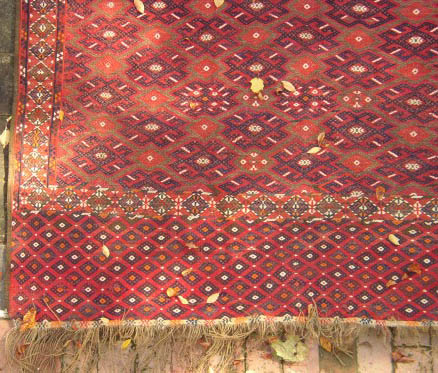
Could this Hash/Kochak gul be a tessellation? Follow the
link to a discussion of Tessellation here on Turkotek.
Dave
TurkoTek Discussion Forums (http://www.turkotek.com/VB22/index.php) Posted by David R.E. Hunt on 03-23-2005 08:23 PM:
"Hatch" Gul = Double Kochak?
Greetings All
We have discussed this in some detail, in a thread here
on Turkotek titled Hash Gul Story Continuation 

Could this Hash/Kochak gul be a
tessellation? Follow the
link to a discussion of Tessellation here on Turkotek.
Dave
Hash Gulesque
All
Notice the Hash Gul like pattern in the field of this Yomud/Tekke
prayer rug.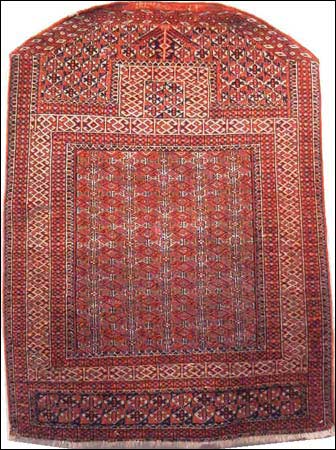
Is there a pattern of association between flat weave
patterns and prayer rugs, and if so could this be
indicative of a history
of flat woven prayer mats?
Dave
Bonjour David
I do not aggree with your hypothesis about relations
between the design of the Yomut palas and the haç gul. Haç gul is an
"autonomous" old design that doesn't derive from other gul's forms. It is
employed as a combined field motif (with a pavement like arrangement), as a
continuous border or stripe motif or as a single "floating" motif.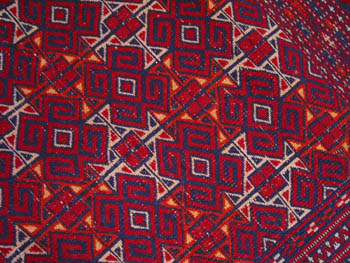
In the case of this
little rug, the "traditional" S shapes are replaced by hook designs that are
connected with the haç gul central design. They are not connected with the white
square that is situated between the haç guls, as you can see in the closeup
picture of the back of the rug. From a certain distance the hooks seem to make
the classical "kotchak" motif with the white squares, but this figure is not the
real design. It is possible that the weaver has attempted to make a synthesis
between the classical "S haç gul" and the kotchak pattern (from the flatweave
field model). But in the general case there is no relation between haç gul and
kotchak.
In my opinion there is nothing in common between specific
flatweave Yomut "palas" design and the guls of piled rugs. The general rule for
the use of specific motifs is that the motifs fit only with one or two specific
types of item. For exemple the kotchak motif of the Yomut palas is just to be
found on certain çuval types (and with the same brocaded technique). This design
is never found on piled rugs. In the same way we don't know any palas
with a
piled main carpet design. And the argument of specific technic = specific design
is not a sufficient explanation. For exemple the piled band technique is not
incompatible with classical "gul" design but we don't know any piled band with
gul design. On the contrary we know piled rugs with piled band design, but we
don't know if it is not a commercial-drived
production. Haç gul is done on
piled technic for rugs of different
dimensions and shapes and for little
bags, and is done on brocaded way for chuvals. But we don't know any palas done
with the haç gul motif. In Anatolian production we know haç gul in soumak and
zili technics.
About the possible origin of the yomud palas "classical"
design I thing we have to see toward old Turkish motifs as it seems often the
case for "utilitarian" items as bags, felt rugs. Palas are items rapidly made
(as the felt rugs, but less rapidly) for covering the ground in the yurt and for
a everyday use. Main carpets are not everyday items. This fact can explain:
first that the design of palas is archaic and without great variations in the
time; second that we don't know very old ones (they have been rapidly worn out).
This is the contrary for main carpets: slowly made items, well preserved in the
families as great value items. In this context it is normal that the designs of
the palas and the rugs are never the same.
Amicales salutations à
tous
Louis Dubreuil
Louis
You state in your post above that
"Palas are items
rapidly made (as the felt rugs, but less rapidly) for covering the ground in the
yurt and for a everyday use."
I admit I am especially interested in the
process by which the
palas is made and the conditions under which it is used.
Are you familiar with any books which discuss the use and manufacture of the
palas, or do you possess any first hand information regarding this subject?
Hello Dave
The best document for "palas" is Parvis Tanavoli's book
"PERSIAN FLAT WEAVE" that is very precise on its definitions of the different
types found in Persia and its borders. In this book he considers the palas,
through literature and documentation, as being a flatweave for ground covering
made with special technics (see other post that gives the Tanavoli's definition)
that well differentiates palas from "gelim".
In this book Tanavoli shows
one palas woven by the Yomud "Gulkan" from Mazandaran 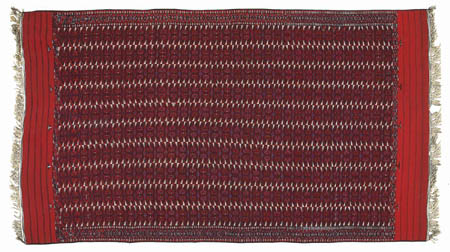
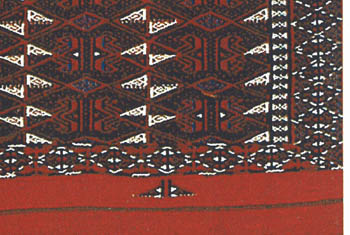
This type is
different from this salon's type with the simple kotchak motif.
We can
see the same motif on a yoruk weaving.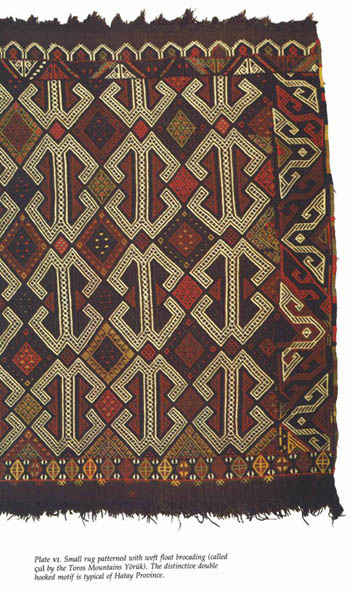
In the Dave's palas as in
the two others shown here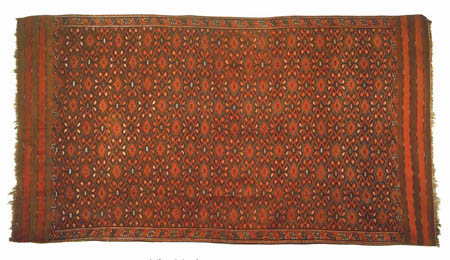
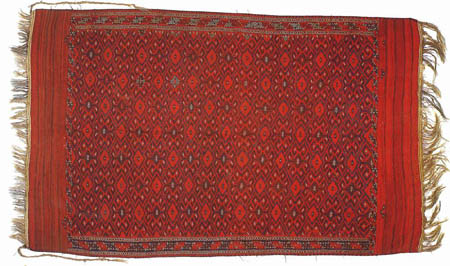
we can see the double kotchak, the same than the one on
this
yoruk bag. 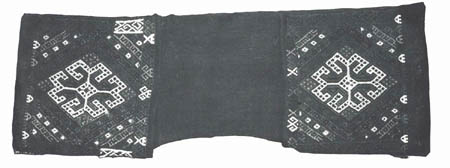
We have also the same design on Turkoman bags as this Yomud
torba.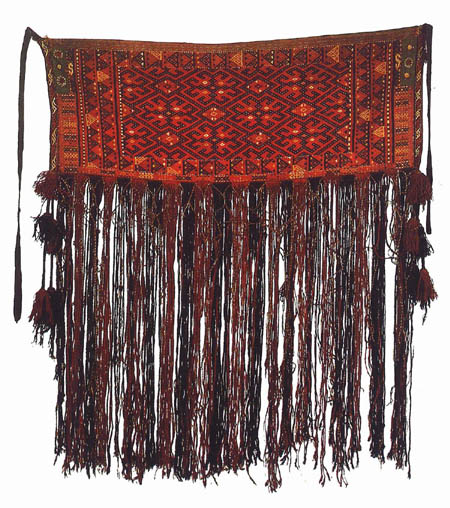
The
shape of the horns of the kotchak motifs are quite archaic as we can see on the
Anatolian village rug attributed to the 17th cent or earlier (HALI,
#112).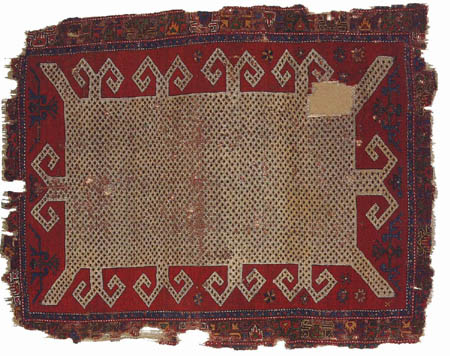
Bonsoir à tous
Louis and All
Thanks for the Images. There are numerous manifestations
of these palas/Kochak designs, but all seem to me to have the same basic
symmetry. Interesting that you cite this west/east,
Yoruk/Turkmen dichotomy.
Would you agree that the repetoire
of those weavers closer to the geographic
origin of a design
would utilize said design with greater frequency than
those
further away?
Dave
haç gul namazlik
Hello Dave
Could you tell us where did you find the picture of the
"yomut/tekke" namazlik ? The first thing I would know is either it is yomut or
tekke, as it is "difficult" to be both. It would be fine to know the knotting
for it is a good origin indication. If it is tekke this would be the first time
I see a tekke "haç gul".
Merci d'avance
Louis Dubreuil
Tekke?
Hi Louis
I double checked on this rug in the Yomud type trapping,
and it is listed as Tekke. Iv'e seen one or two others of this
prayer(?)
type executed by the Tekke, but this raises
a couple of flags with
me.
If the earliest Tekke prayer rugs are fairly recent
developments,
these would be late, and we know
what happens to weave and tribal affiliation
as
time advances.
Much later Yomud work is in the asymmetric knot,
and I myself have seen much which I thought
Yomud described by the
dealer as Tekke, so
without a direct inspection I would tend to error
on
the side of caution.
Perhaps someone with more experience in this
area
will speak up.
Dave
Tekke?
Sorry, Typo error
More palas
Hi David , Hi Louis,
To further reinforce Louis' contribution above , I am
posting images of a palas of the first type with Ram Horns and secondary diamond
centres. 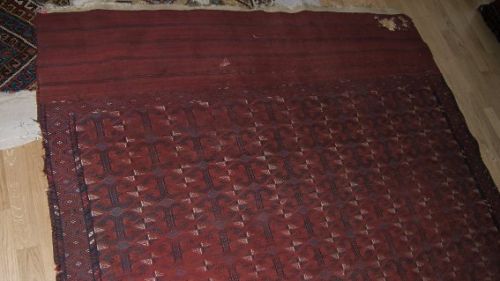
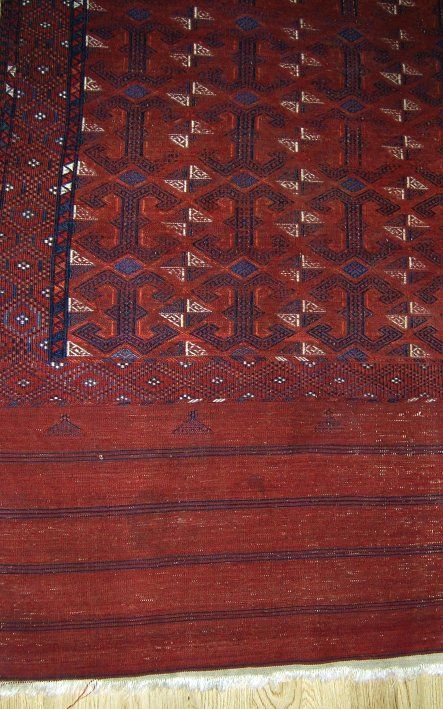
I
acquired the piece to study the relationship between these designs and the
Anatolian brocaded cover designs.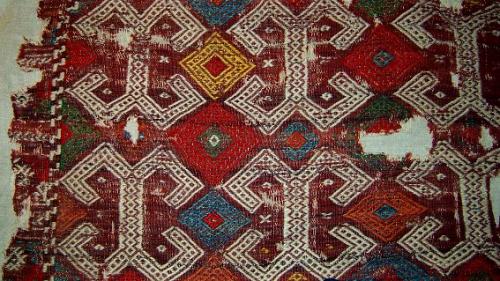
The similarity is obvious. The
Anatolian piece is pretty old and the Turkish "pelt rug" posted by Louis shows
clearly how the Kotchak form was transferred from brocading-zili technique. The
Turkmen palas also looks of good age. It has 10x17 Ram Horn main motifs. The
one, Dave, you have posted for this salon is 12 wide by ? . An example sold at
Rippon Boswell in May 1998 is more crowded with 13x24 ram Horn designs and , I
also found an example in the De Young museum (Mc Coy Jones ) with up to 30 long.
The one posted by Louis is also 10x30.
The palas shown here has impressed
me by its nice spacing, the fine weave, the quality of the colours , the
generosity of the elem dimensions and its border techniques.
The
border is worked in a 3+1 zili technique.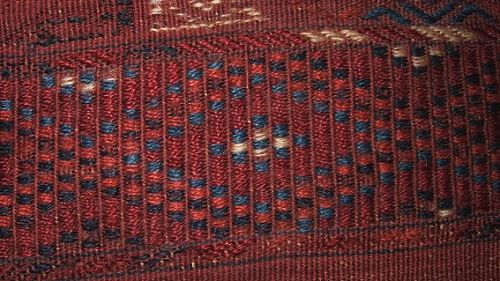
The interesting
relationship here is with the border design of some Salor pieces. The below
scans from the book " Turkmen - Mackie-Thompson" show clearly that the piled
elem designs of the bags and trappings can be assumed to be taken from brocaded
media .
Look at the main border of the trapping with losenges formed by
small rectangles. It is the same as the one from the palas .That occurred to me
after having acquired and studied this palas.
A possibility is , that in
earlier times , these areas were made with the brocading and were not piled. So,
if somebody finds a Salor trapping with a flatwoven , brocaded elem , that piece
could be older than all the known examples (this is a bit of deductive
archeology where we predict the piece as it must have existed !)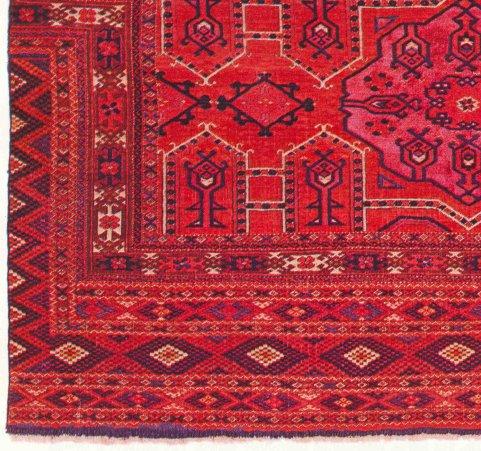
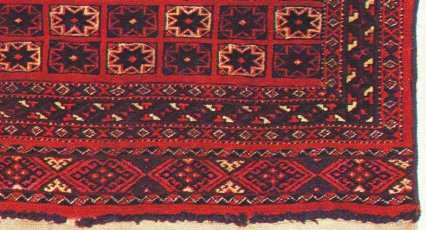
For further discussion , I am
also attaching details of another Anatolian brocade that relates to the Palas
type 2 . 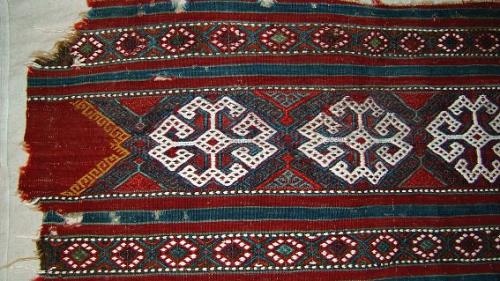
I
did not see any relationship in piled media as a gul neither in Turkmen nor
Anatolian. My feeling is that the gul designs are going to very old traditions
and that the pile media and the flatwoven/brocaded media have developed their
own gul types as archetypes. The piled media , being more flexible and being
under more commercial influences has been easier to adopt designs from other
sources when the tribal traditions loosened or were due to change. This could
not happen to the flatwoven /brocaded ones because the technique has forced to
distilled forms of beauty over very long time. This could not be so easily
reinvented.
Ali
Been Here before...
Ali and All
Thanks for the input. Myself and Louis have been
through
this to some extent before, as demonstrated by the
linked thread,
and while I don't think our two "theories "
or ideas are mutually exclusive,
I think Louis'
Hash Gul Classification needs to be better
documented.
I actually came across one of these large scale flatweaves,
as in your third image, in a shop here over the weekend.
For all
practical purposes it was made yesterday with some
poor dyes, but it was
interesting. How are they related?
Who can say?
The Chamtos border,
worked in zili is interesting, but is this a traditional
Turkmen weave
technique and/or motive? I know the
chamtos, or something quite similar,
occurs with frequency in
work by people of Mongol extraction.
Also, I
find it interesting that this first palas image bears a
strong similarity to
the first of the salon, a palas which has
been tenetatively attributed to the
Tekke. What is the
attribution, if any, of your palas?
Dave
Hi Dave, Louis, Ali and All,
I wonder that what is the diffrents
between Kotchak and Ram Horn, also the diffrents between palas and kelim
.
Isn't all same meanings ?.
Regards.
Hi David, Hi Cevat & all
1) I am not knowlegeable enough to
determine the attribution of the palas posted above. In the literature, there
are references to Tekke. The Rippon Boswell piece was catalogued as Tekke.
In
the Rickmers Collection book Robert Pinner refrains from any definite
attribution of two other types of flatweaves, both in structure similar to the
one I have.
To me , the warps are looking like Tekke wool, the side finishes,
the elem and borders might indicate relationship with Salur and the colours
might be both Tekke and Salur.
One interesting feature though is that the
wefts seem to be double at every shot. Does that indicate any direction for the
attribution ?
2) About the zili border my main point was to question
whether there would be any transfer between the Salur pile trappings and the
zili borders from the flatweaves. If that is the case that would indicate a long
history of "brocaded" flatweaving in Turkmen areas.
3) The relationship
between the designs of Anatolian brocaded flatweaves and the small corpus of
Turkmen brocaded flatweves is an interesting subject of study. This definitely
points to the design transfer from one region to the other via migrations , but
again, also might prove the existence of a long tradition of these type of
weavings in Central Asia.
4) To my understanding the term "Kotchak"
defines just a pair of Ram Horns.The design on the Palas and the Anatolian
brocade is having two Kotchaks symmetrically placed around the horizontal axis.
This is why I called it Ram horn main motif.
Maybe we should call it
mirrored kotchaks or = aina kotchak. But I am not sure this name has not been
given to another combination ?
Ali
Hi Ali ,Dave ,Louis and All,
Turkic Republics in Central Asia
{
Azerbaijan,Uzbekistan,Turkomanistan and Kirgizistan }
Palas,Gelim,Kelim and
Kilim has the same meaning, in english they call it Flatweaving .
Kochak
is a Turkic word, it means, KOCH : RAM , AK: WHITE
it may mean Ram's white ,
i do not know what they call it the horn in turkic republics but the main word
expreess the word , wich is KOCH: RAM.
In Turkey this design known as
koch boynuzu : ram horn
The ram horn design goes back to Shamanism wich
all Turks were.
It is a sembol of helper, guardian and power. in present time
we are still using some Samanist elements in our lives.
Below images are
from a home in Turkomanistan.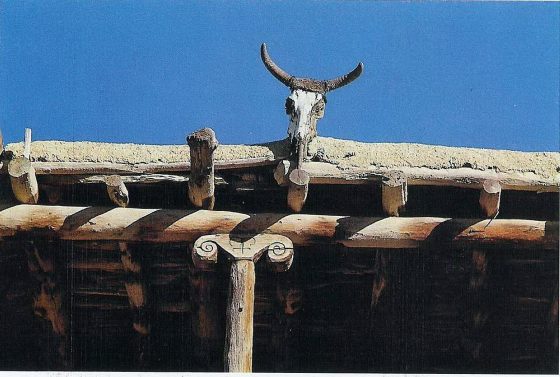
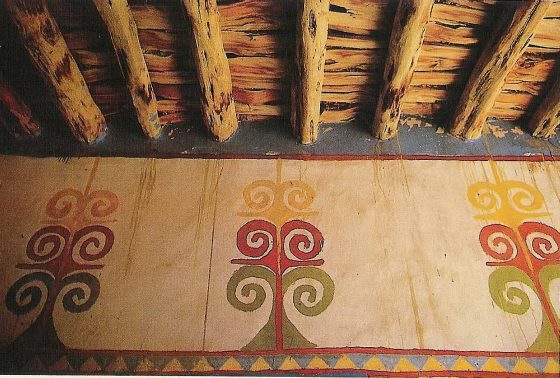
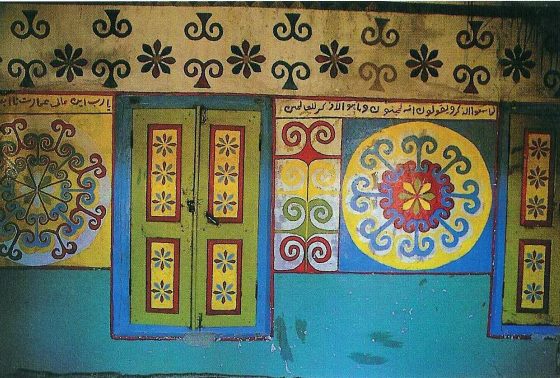
Below image is very
interesting , some mosque in Turkomanistan are still using old Shamanist figures
that Islam Doesn't except, it is just an old tradation.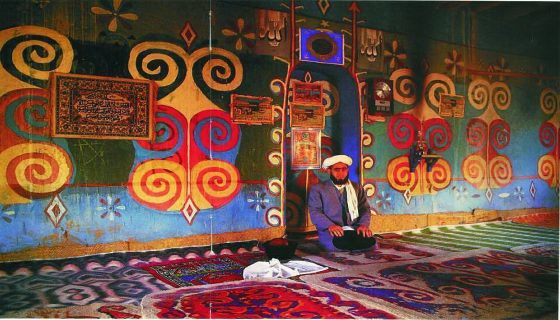
Regards.
Hi Cevat
Most ruggies use "kelim" (or any of the spelling variations)
to refer to slit tapestry. Trying to educate them to do otherwise is probably a
waste of time at this point.
Regards
Steve Price
City vs. Country
Hi Cevat
Thanks for the Images, especially the mosque.
Interesting.
Just a point or two I would like to mention in
passing.
In the first instance, it is my understanding that ram's horns,
as "natural" symbols are to be found most where ever we find rams, so the kochak
itself is not necessairly Turkic. There are quite a few Arabs in Turkmenistan,
so it could hypothetically be Arab, or even both Turk and Arab.
Secondly,
it is my understanding that the majority of urban dwellers and the ruling class
of Turkmenistan are Uzbek and hence more at mongol than Turk, so I would expect
building decor to be rather more a reflection of Uzbek "taste" if you will than
Turkic. Compare your images above to these examples of Uzbek crafts, noticing
the colors and of course the kochaks.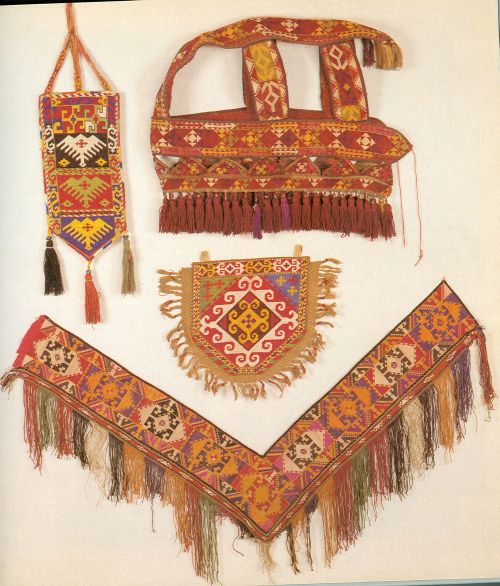
What does this all mean?
I'm not sure but ,I do know we have to be careful with this symbol
stuff.
Dave
Design Migration...
Hi Ali
You stated above that
"The relationship between the
designs of Anatolian brocaded flatweaves and the small corpus of Turkmen
brocaded flatweves is an interesting subject of study. This definitely points to
the design transfer from one region to the other via migrations , but again,
also might prove the existence of a long tradition of these type of weavings in
Central Asia".
Notice the "lappets border" in the weaving above and consider the
following from Gerard Paquin's
Silk and
Wool: Ottoman Textile Designs in Turkish rugs
The theme of
architectural conventions used in textiles and rugs is one to pursue when
considering the yastik, or cushion cover form. Perhaps the most widely
recognised imitation of Ottoman textiles by rugs is the use of velvet yastik
designs in wool pile versions. The yastik is a popular format for Ottoman
velvets from at least the 16th century onward. Many knotted pile wool yastiks
from the 18th and 19th centuries preserve the velvets' designs.
One
curious feature that became a convention in both silk and wool yastiks is the
single row of small compartments, or lappets, that frequently appear on each end
. The logic or reason for their existence is not immediately apparent, but a
consideration of how velvet yastiks were woven and used suggests some answers.
Weaving a velvet on a drawloom is quite mechanically done, but the
setting up of the sequences for the manipulation of the loom to produce the
design is a complicated task. The shorter the length of weaving before the
design repeats, the easier the set-up. Thus a cloth with repeating carnations
has a repeat one carnation long and is easier to program than a medallion design
. Once the loom has been set up with a repeating design, meter after meter can
be woven off. Then, if desired, the cloth, typically only about 65cm. wide, can
be sewn side to side to make a continuous broader design.
The
simplest way to transform a piece of fabric so it becomes a useable object
straight off the loom is to introduce rows of lappets periodically. One thus
creates a series of identical yastiks, as many as the length of the warp can
accommodate . In the simplest way, with the least reprogramming of the weaving
sequence, a piece of fabric has had its ends "finished." It has been made
into furnishing and appropriate to an architectural setting.
Perhaps it
is not surprising that there are so many examples of wool pile yastiks with
textile-like patterns in this same design concept. They have repetitive field
patterns, little in the way of side borders, and lappets on each end . Often the
lappets have shrunk from their original proportions on velvet yastiks, but they
remain as a reminder of their architectonic defining purpose.
The
choice of lappets as a type of end border in defining the form of Ottoman silk
yastiks and their wool descendants evolves naturally from the artistic heritage
embraced by the Ottomans. Timurid and Jalayrid miniature painting depict yastiks
in use, some of which have forms analogous to the end lappets of Ottoman yastiks
. In those same paintings we see shapes in rows like lappets used generally as
dividers or borders in a variety of architectural uses. Examples of the use
of rows of lappet shapes to demarcate a space can be seen on tops of walls , as
decorative friezes such as on the socle or edge of raised platforms for sitting
, and elsewhere.
There are of course many velvet yastiks, and their
knotted pile descendants, which do not use repeating textile patterns. Those
with medallion designs we consider to be inspired by the art of the book. There
are two other influences to note, however. First, the appearance of lappets at
each end has become a defining convention. They usually remain, even when other
borders have been added. Second, the yastik with borders all around is an echo
of the architectonic design of the oriental carpet. Rugs, composed of borders,
guard stripes, and central fields, have always been used to define spaces in
both tent and town. So while the Konya-Beyshehir mosque carpets imitate textiles
with their closely patterned fields, they establish an architectural grandeur
with their wide borders .
Do these
come in a variety of sizes,
and if so, what range?
I noticed you stated that "this definitely points
to the design transfer from one region
to the other via migrations". Am I
correct in assuming that you discount the possibility
that these might
represent a simplified copy or reinterpretation of the Turkmen palas
design?
If whole boatloads of these palas can show up in a store here
in
Washington D.C I don't see why they couldn't show up in a sook in
Turkey.
Dave
Hi Dave,
Could you let us know that what is your base that Ram horn
design is kochak and what is Kochak ?.
Kochak { kocak} is a town in
Aydin/Turkey , there are Turkomans in Aydin area, Aydinli Kilims was woven by
turkomans goes back to 1800's
Regards.
Kochak
Hi Cevat
As I stated earlier
"I do know we have to be careful
with this symbol stuff",
and I stand by this assertion. The rug books
refer to this ram horn
like motive as "kochak", which is shorter than "Ram's
Horn",
but I don't believe there is any easy answer.
It might be accurate
to refer to this symbol by whatever approximates
the word "Ram's Horn" in
what so ever language.
In short, the nome Kochak in itself may not be of any
particular significance.
Could be just a convention.
Dave
Hi David,
From your post I understand you think that the Anatolian piece
was made as a yastic with composite designs taken from elsewhere , and maybe
from the Palas seen in the bazaars ?
The Anatolian brocade with that design
are relatively common and they predate the appearance of the Palas in the
bazaars recently or even in early 20th century. The design has been woven
traditionally in Anatolia. The image in Louis Dubreuil's post above is(Plate VI)
from Anthony N. Landreau and Ralph Yohe , Flowers of Yayla. Both authors have
extensively carried field research with the Toros mountain Yoruks in Anatolia.
They publish several examples of the same design , especially the Arthur Jenkins
piece as fig 24th , which is measuring 1.93 by 1,57 m. So this design was used
in pieces of all dimensions.
The piece I have posted predates all the pieces
published in that book as there are several archaic features that would be too
long to discuss here or on the monitors. It is about 105 cm by 210 cm.
So ,
we do not know if the Palas design is a derivative or vice versa. I would rather
opt for a diversification of the design and maybe more "Turkmenization" on the
palas with the minor / major Gul language versus the geometrical space and
colour development in the Anatolian piece.
The Palas have loops sewn on the
sides that indicates that, at least at some point in time, it was used as a
hanging. But this might not be the original function.
Ali
Who Can Say?
Hi Ali
No, I don't actually believe that the Yourk piece is a knock
off,
just a hypothetical example of how this design could have migrated into
Turkey.
It is fair to discribe these Yourk
pieces as generally smaller
than the Palas?
No smaller format bag faces then?
You state
"The piece I have posted predates all the pieces published
in that
book as there are several archaic features".
These features might be
worthy of discussion. Marla Mallett,
in her essay Tracking The
Archtype states
Design influence flows normally from restrictive to
less restrictive techniques. Design features that are dictated by structural
limitations clearly indicate their origins. Structural problems should alert us
to outside influences. Inconsistencies in design execution often indicate
diverse design sources. Fine articulation, cohesiveness and strong
positive/negative design relationships can point us toward likely origins. And
last, design change and disintegration is accelerated as motifs migrate from
medium to medium, since different technical constraints apply.
Is it
possible that these "archaic features" might in fact
constitute
"inconsistencies in design execution" as
above?
Curiously,
Dave
Hi David,
the Anatolian pieces with that design can be about 1m40 by 2m50
or even bigger. There might have been smaller pieces . I do not know them but
the Yoruk are pretty creative to adapt the designs to any format. So , I would
not be surprised.
What I meant with archaic features are the following
:
1) Colour quality of extra wefts and also the specific colour tone of the
background weave. This can not be observed on the monitor and can only be seen
in flesh.
2) The execution of the "symmetrical kotchak" figure in brocading .
Remark the little sawteeth pattern in white wool on the part that links the two
kotchaks together. That is a special attention to detail and workmanship that
does not exist in the later piece.
3) the arms of the kotchaks on the later
piece close completely , providing less variety for the negative space
4) the
colour arrangement and the special proportion of the losanges around the
kotchaks and the overall clarity of the design versus the cluttered appearance
of the Yoruk piece.
In addition (I will have to find a bigger picture later )
the piece has a border made of little squares with the same triangular elements
that form the" minor guls" on the Turkmen Palas. It also has elem like designs
at each narrow side outside the main border.
These all speak for earlier
brocaded pieces and one develops a sense of design evolution as several pieces
with the same design can be compared.
Ali
Archtype?
Hi Ali
Interesting. I dont know enough to say, as you indicate
some
of these characteristics are not discernable from
a photo, but within the
context of Marl Mallett's
Archtype Theory it seems that these additional
characteristics could evidence techniques or structures
deviating away
from a cohesive design origin and hence
further removed from the
original.
It would be interesting if there exist corresopnding
age
based differientations among palas and
a correlation between the two,
Turkmen
and Yoruk.
I will have to check out this "Flowers of Yayla"
for
myself and see what is going on, this will be interesting.
Thanks,
Dave
Diversity = Evolution
Hi Ali
I recieved my copy of "Flowers of the Yayla", and although I
have yet to give it a thorough going over I have read enough to suggest, judging
from the diversity of weave techniques and the multitude of variations upon this
"kochak"motive, that these pattern and these bags are of central import in this
area and these people anmd perhaps of no significant filial relationshup to the
palas.
The weave techniques and patterns of the Yoruk are a direct
contrast to the palas. Where the Yoruk vary much in structure,the palas is
remarkable in it's uniformity of construction. Where we see endless variation
upon a basic design theme among the Yoruk, we see a few basic designs over and
over again in this palas.
Maybe these similarities are just that of flat
weave techniques found over a vast geographical region and the limitations which
symmetry impose upon a two dimensional surface, horizontal, vertical, and
lateral.
Did you notice the More Palas Pictures thread and it's assertion that the palas
is "the" common floor covering of the Turkestan region? Also, check out the tail
end of The Lattice thread where I try to put this all
together.
Dave
Hi Ali
Find below some examples of this Yoruk "cul" or bag from the
Icel province Toros mountains in Turkey.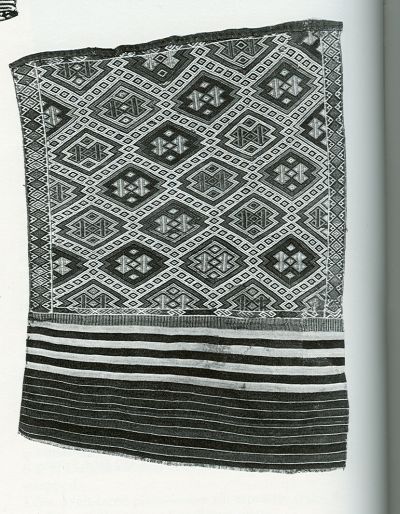
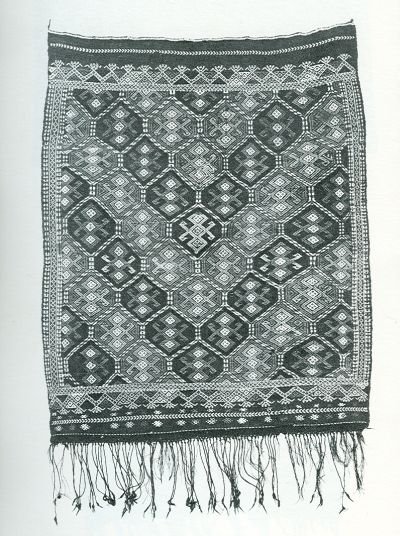
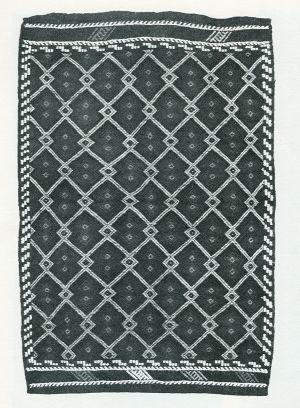
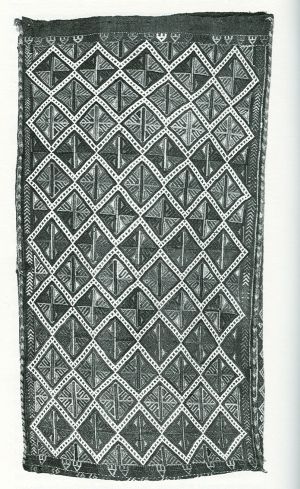
Of this last image Yohe
states
"Perhaps the most popular layout is rows of large hexagons,
staggered to form diagonals, such as in Plate XI. Various motifs such as the
cross, star, arrows "birth symbols", diamonds , "slit belly", ect. may be
included within the overall hexagon pattern as secondary elements. The
variations are endless."
Interesting that both the weave technique and
this prominent flatwoven bag format share the same name.
Yohe states
that
"The most common type of weaving presently done in Icel province is
a kind of weft float brocading known elsewhere in Turkey as zili, but called cul
by the Yoruk in Icel."
Dave
Structurally Generated?
Hi Ali and All
Anita Landreau posits an observation in her
contribution in "Flowers" during her discussion of weaving and of warping
specifically, that
"Threads are cut by groups of four, because typical
Yoruk cul patterns are based on four units. A marker is inserted at intervals to
keep track of count."
This goes far in justifying a structural origin of
these designs?
Yohe makes reference to damgas or tribal marks or
brands used to identify livestock and at least suggested by some design elements
in weavings. Joy May Hilden discusses a similar practice among the Saudi
Bedu on her World of Beduin Weaving
Kelims
Hi Ali
Just an aside here, a couple images of some kelims and their
accompanying captions..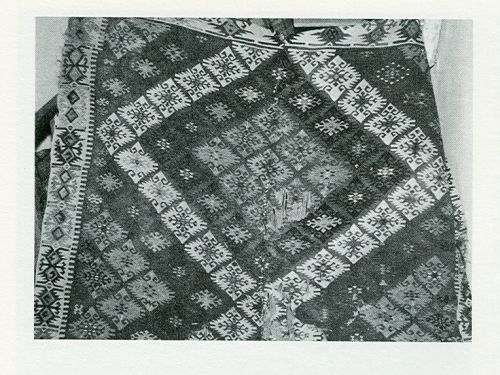
"An old wollen kelim in the mosque at Tuzla, similar to kilims
found in the Nigde, Kozan, and Hatay regions. They were made by the Tuzla Yoruk
several generations ago before they stopped going to the
yayla."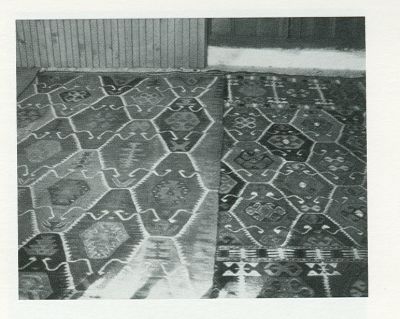
"Typical Kilim from the mosque in Kas Antalya province, probably made by
Sacikara Yoruk."
Somehow these kilims don't strike me as being typical,
especially the one on the left
Dave
Hi David,
I am right now on vacation on the Toros mountains and have
scarce access to the net. I will reply when I am back.
Ali